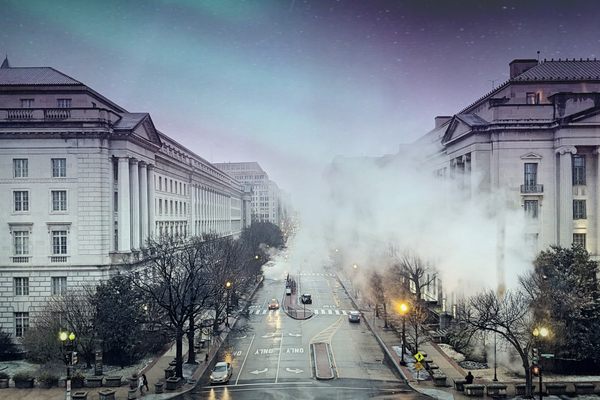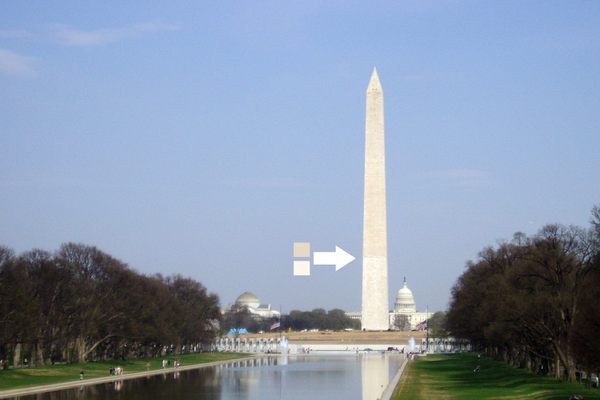What Do You Do When the President Gets Trapped in an Elevator?
LBJ, the Pentagon’s only passenger lift, and concern that a military coup was afoot.

It was about two minutes before noon on February 29, 1968, when the motorcade turned quickly out of the freezing rain and into the parking garage beneath the Pentagon’s riverside parade ground. The presidential stretch limousine pulled to a stop in front of the elevator leading to the office of Secretary of Defense Robert McNamara. Lyndon Johnson emerged with a handful of aides and shook hands with the Secretary, who was waiting there for him.
The two shared amiable words, but Johnson was there to kick McNamara out of office with a “promotion” to the World Bank because of his handling of the Vietnam War, which had claimed the lives of 11,363 American soldiers in the previous year and was fueling protests across the country. A thousand spectators and an honor guard of 150 were waiting above for a ceremony to honor McNamara’s service to the government.
McNamara pushed a button and summoned the elevator that led directly to his office. It was, in fact, the famously large building’s only passenger elevator, since when the building was constructed in the 1940s, architects eschewed elevators for concrete ramps to conserve steel for the war effort. (More have since been installed.)

As the elevator passed the second floor, it unexpectedly lurched to a stop.
“Isn’t there an emergency switch?” someone blurted out. McNamara told an Army sergeant, “You’d better use the phone.”
“What’s wrong with this thing?” the president asked his aides.
White House Deputy Special Counsel Lawrence Levinson was one of the 13 crammed into the elevator, and recently described the event in an interview. “There was some gnashing of gears, but otherwise an unbelievable quiet … immediate thoughts were, ‘Why now? Was there something sinister going on?’”
At the time, the world appeared to have been on fire. On top of the morass of the Vietnam War had become, the preceding year had seen eight military coups, realized or attempted, around the world, an almost unimaginable level of geopolitical chaos, even by today’s standards. Things were, at the very least, tense.
Levinson’s first thought was that he was experiencing, first-hand, an attempted coup by the U.S. military on McNamara’s last day in office. “Was someone about the inject some type of gas into the lift or drop some form of explosive? We had the head of state and the Secretary of Defense in one small place that was undefended and vulnerable. A natural site for an extraordinary disaster.”

By this point the lone Secret Service agent in the elevator had radioed his colleagues to “open the damn doors” on every floor, and a colonel could be heard sprinting up and down the stairwells shouting, “They’re stuck! They’re stuck!”
Air Force One pilot James Cross, also in the elevator, remembers how it “felt like we were breathing stale air, so the president told Will [Sparks, speech writer] to try to get some more fresh air.” They pried open the elevator door a smidge and jammed the President’s notebook and speech in the opening. Ten minutes had elapsed since the president had functionally disappeared, and the Pentagon brass apprised of the situation were in a state of panic.
Finally, at the 12-minute mark, the doors were wrenched open by a General Services Administration maintenance man and several others. With only a portion of the elevator compartment open to the landing, workers squeezed down a desk chair. Johnson stepped up and was heaved out by Secret Service agents.

With the president freed, pulses lowered and the group made their way to the waiting ceremony. Out in the rain, the president awarded Robert Strange McNamara the Distinguished Service Medal, before a 21-gun salute courtesy of thunderous 105 mm howitzers. Then he fired the man and drove off.
The LBJ Presidential Library in Austin, Texas, preserved a sentence-long memo that was drafted three hours after the elevator fiasco by domestic advisor Joe Califano. “Secretary McNamara told me that before he left, he wanted you to know that the GSA runs the elevators in the Pentagon not the Department of Defense.”
A week later a second advisor concluded the episode with a final memo: “you will be happy to know that the GSA has ‘corrected’ the problem of the Pentagon elevator. When 13 of us were stuck in it,” the memo continued, “the sign said: ‘Capacity - 15.’ They changed the sign. It now says: ‘Capacity - 12.’ They are debating whether to make it 10.”





















Follow us on Twitter to get the latest on the world's hidden wonders.
Like us on Facebook to get the latest on the world's hidden wonders.
Follow us on Twitter Like us on Facebook